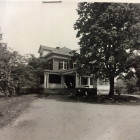Now & Then
New Canaan Now & Then: The Crofoot Ireland House
|
‘New Canaan Now & Then’ is sponsored by Brown Harris Stevens Realtors Joanne Santulli, Karen Ceraso, Bettina Hegel and Schuyler Morris. The Crofoot Ireland House located at 634 Silvermine Road has a rich history and dates back to 1800 (the New Canaan Landmarks dates it at 1796).
Silvermine in the early days was owned almost entirely by the St. John Family. In 1717, Ebenezer St. John deeded 20 acres on the east side of Canoe Hill to his son, Daniel.




